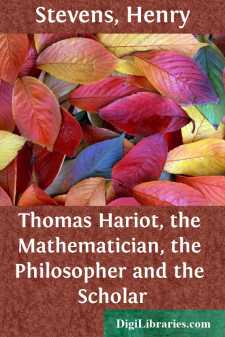Categories
- Antiques & Collectibles 13
- Architecture 36
- Art 48
- Bibles 22
- Biography & Autobiography 813
- Body, Mind & Spirit 142
- Business & Economics 28
- Children's Books 17
- Children's Fiction 14
- Computers 4
- Cooking 94
- Crafts & Hobbies 4
- Drama 346
- Education 46
- Family & Relationships 57
- Fiction 11829
- Games 19
- Gardening 17
- Health & Fitness 34
- History 1377
- House & Home 1
- Humor 147
- Juvenile Fiction 1873
- Juvenile Nonfiction 202
- Language Arts & Disciplines 88
- Law 16
- Literary Collections 686
- Literary Criticism 179
- Mathematics 13
- Medical 41
- Music 40
- Nature 179
- Non-Classifiable 1768
- Performing Arts 7
- Periodicals 1453
- Philosophy 64
- Photography 2
- Poetry 896
- Political Science 203
- Psychology 42
- Reference 154
- Religion 513
- Science 126
- Self-Help 84
- Social Science 81
- Sports & Recreation 34
- Study Aids 3
- Technology & Engineering 59
- Transportation 23
- Travel 463
- True Crime 29
Thomas Hariot, the Mathematician, the Philosopher and the Scholar
by: Henry Stevens
Categories:
Description:
Excerpt
Shortly after there was erected to his memory in the chancel, at the expense, it is understood, of his noble friend the Earl of Northumberland, a fine marble monument, bearing the above neat and appropriate inscription.
St Christopher's, a very old church, with its records (still preserved) extending back in an almost unbroken series to 1488, passed through many vicissitudes before itwas finally swallowed up by the leviathan of the world's commerce. The site of it is now occupied by the south-west cornerof the Bank of England on Princes Street, to the left of the entrance, nearly opposite the Mansion House. The church was restored and redecorated the year of Hariot's death, and again twelve years later, but was burnt in the great fire of 1666. Hariot's monument perished with it, but the inscription had been preserved by Stow. The church was rebuilt on the same foundation by Sir Christopher Wren in 1680.
About a century ago the church, with the whole parish of St Christopher (called then St Christopher-le-stocks because near the stocks standing at the east end of Cheapside), together with a large portion of two other parishes, St Margaret's and St Bartholomew's, was purchased by the Old Lady of Threadneedle Street for the site of the new Bank of England. Thus one great bank of this modern metropolis covers a large part of three parishes of old London.
The whole area of the Bank, however, was not given up to mammon, though still here men most do congregate, and worshippers most do worship. One small consecrated spot, enough perhaps to leaven and memorize the whole site, was respected, and not built over. It was the churchyard of St Christopher. This ' God's acre' the architect and the governors have dedicated to Beauty, Art, and Nature. The little ' Garden of the Bank of England,' the loveliest spot in all London at this day, measuring about twenty-four by thirty-two yards, was just a hundred years ago the little churchyard of St Christopher, where still repose the bones of THOMAS HARIOT.
Virginia, which once comprehended the present United States from South to North, has been called the monument to Sir Walter Raleigh. So the Bank of England, built round the churchyard of St Christopher, may be called the monument to Thomas Hariot.
The present year, 1879, is just three centuries since Hariot went forth, a youth of twenty, from the University of Oxford. We have briefly told his story. England is all the richer for his life, and the world itself acknowledges the wealth of his science and the worth of his philosophy. The Bank of England is built round his bones, but it cannot cover his memory.
Stay, traveller, tread lightly ;
Near this spot lies what was mortal
of that most celebrated man
THOMAS HARRIOT.
He was the very learned Harriot
of Sion on Thames ;
by birth and education
an Oxonian, Who cultivated all the sciences,
and excelled in all,
In Mathematics, Natural Philosophy, Theology.
A most studious investigator of truth, A most pious
worshipper of the Triune God,
At the age of sixty, or thereabouts,
He bade farewell to mortality, not to life,
July 2d A.D. 1621.
He lived, died, and was forgotten in the parish of St Christopher. Henceforward, whenever Englishmen and Americans, merchants and scholars, rich and poor, men of genius and men of money, enter this little' Garden,' let them read there in English what Henry Percy originally set up in Latin, the above inscription....


